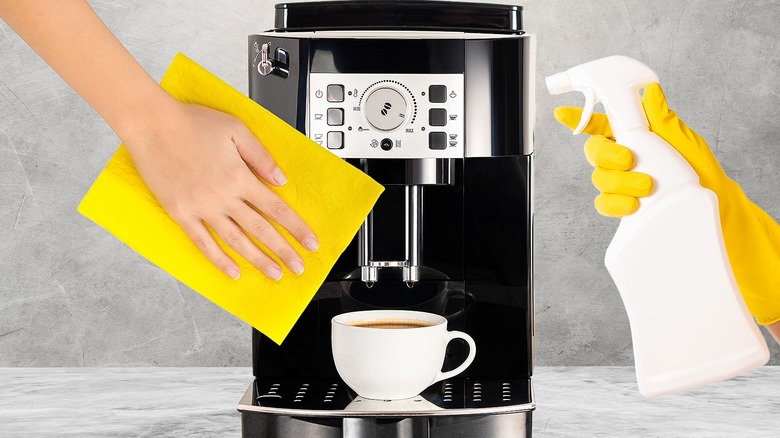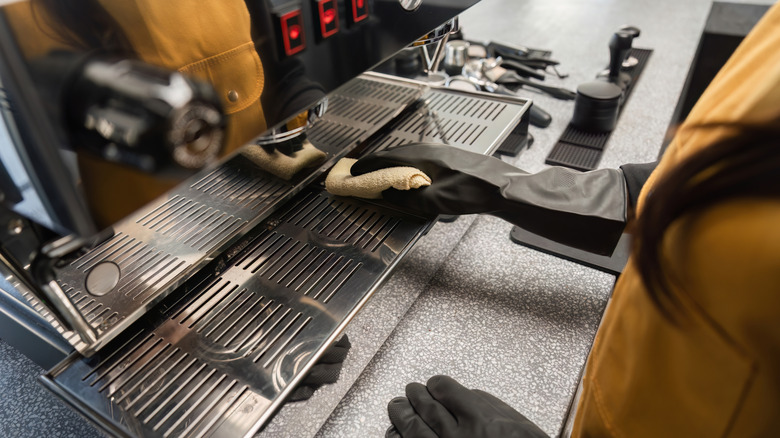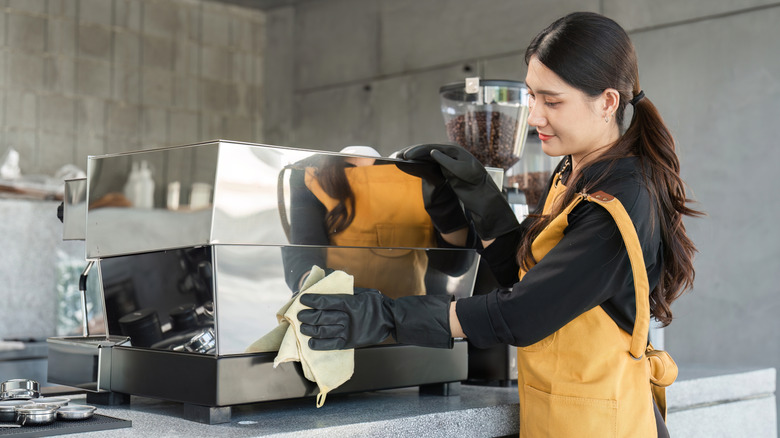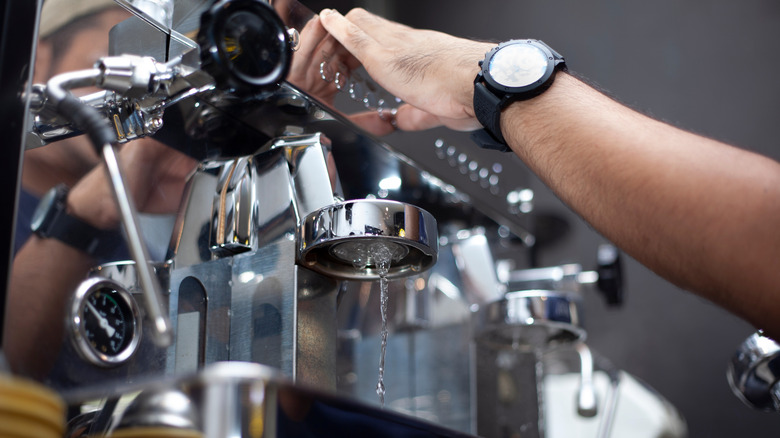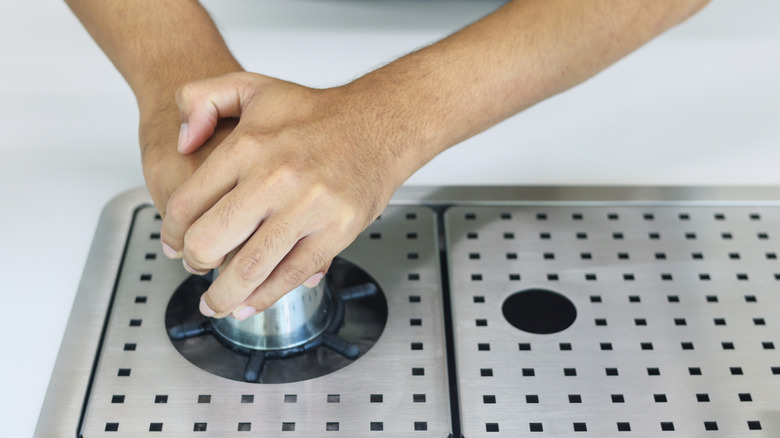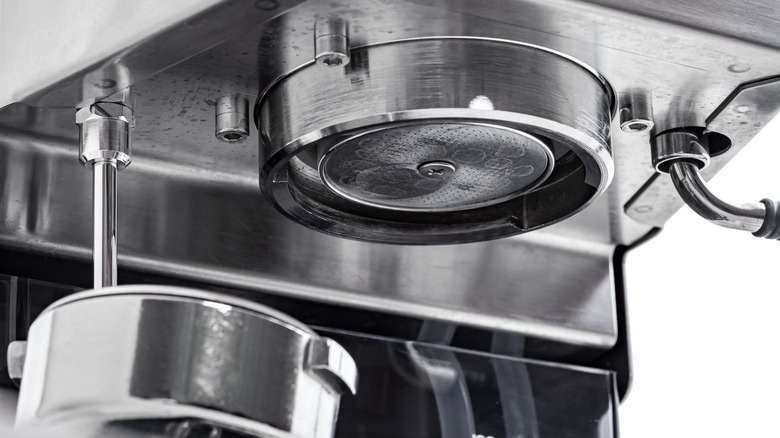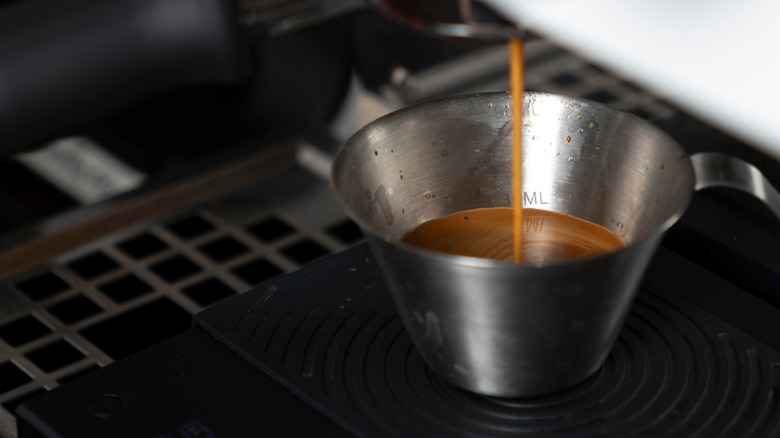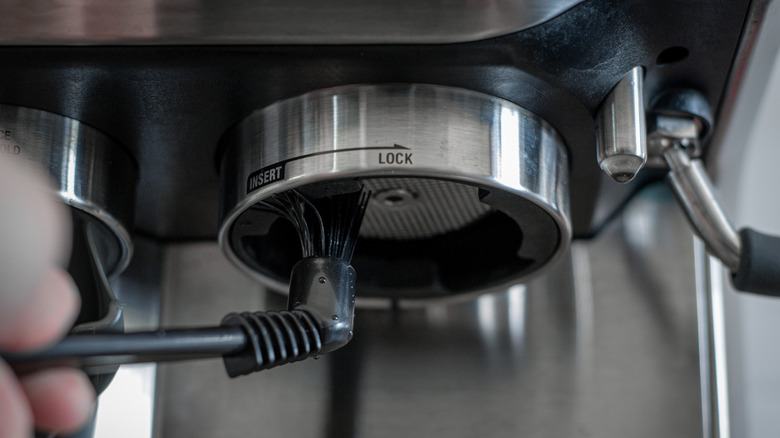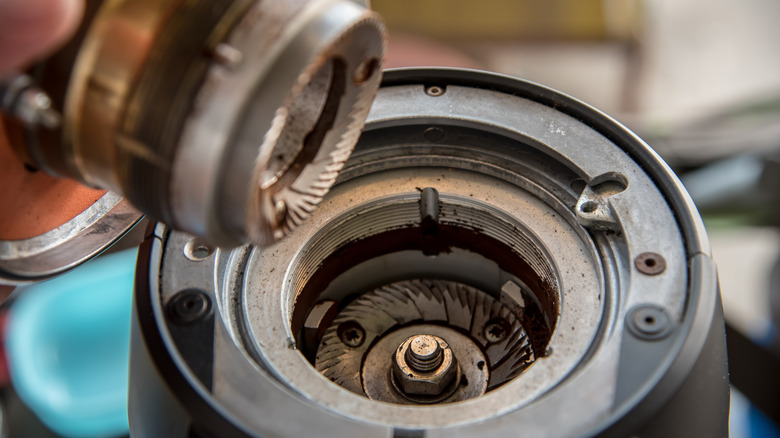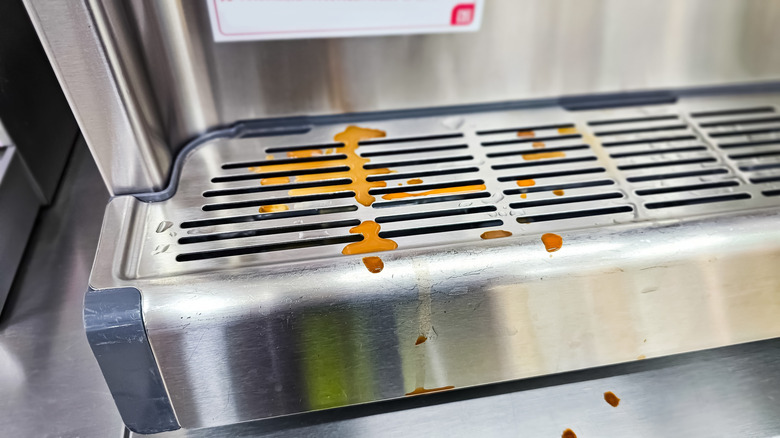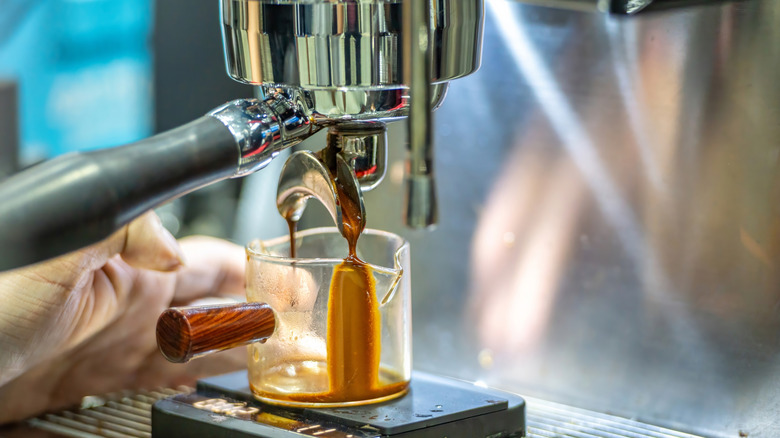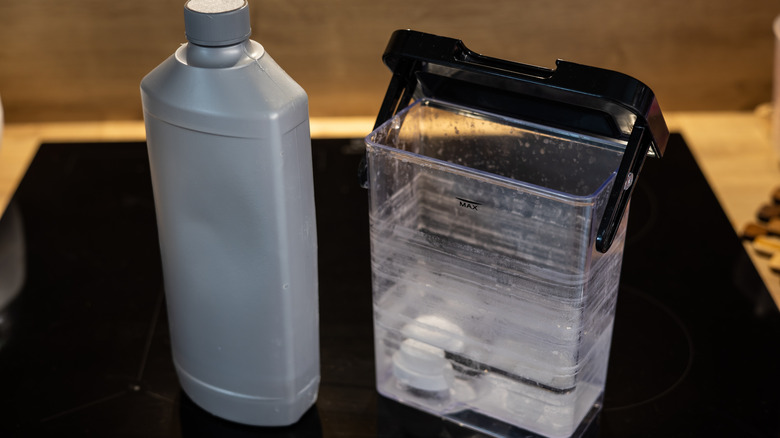13 Pro Tips To Keep Your Espresso Machine Sparkling Clean
You've finally done it — you invested a sizable chunk of pocket change into that home espresso machine you've been eyeing for ages. As a budding coffee aficionado, it feels like you've made it. After all, nothing screams success and hard work like the permanent addition of a state-of-the-art caffeine machine to your home. But, while pulling shots, steaming milk, and trying your hand at latte art can make you feel like you're up there with the bougiest of baristas, none of that will matter if you're not cleaning your espresso machine properly.
Even the best espresso machines require meticulous maintenance if you want them to have a long lifespan. If you're wondering how often you should clean your espresso machine, the good news is you likely won't have to do a deep clean more than every few months (unless you're using it numerous times a day). However, your machine will require weekly and sometimes daily maintenance to be kept in good working order. Neglecting your espresso machine can lead to poor-tasting coffee and buildup of limescale and even bacteria, and it could reduce the overall lifespan of your espresso machine.
As a longtime barista with a decade of commercial coffee experience under my belt, I can testify that keeping your machine clean is vital to both the quality of your coffee and the life of your machine. I'll walk you through how to clean it properly.
Use the right cleaner for each part of your machine
First things first: Don't start cleaning your espresso machine with whatever you have on hand. You'll need different cleaners for different parts of your machine in order to ensure they get a proper clean, as some solutions will be fine for certain parts of the machine but could damage others. For example, while a vinegar and water solution is fine for keeping the outside of your machine spotless, the same solution could cause harm if you use it to back flush your group heads.
In general, you'll want to use a cleaner that's formulated to break down coffee oils while maintaining your machine's integrity to clean parts of your machine that come into contact with espresso. I recommend grabbing a bottle of Urnex Cafiza Powder. I prefer the powder format to the company's tablets as it allows you to dose it differently depending on which part of your machine you're cleaning. If your espresso machine comes with a milk steaming wand, you'll want a different solution that's formulated specifically to clean parts of your machine that come into contact with dairy; I recommend Puro Liquid Dairy Cleaner.
Have a few different cloths on hand
It's good practice to keep a couple of different cleaning towels on hand for your espresso machine, especially if you'll be making drinks for a crowd. As a general rule, you don't want to clean your steam wand with the same towel you use to wipe out your portafilter, and you shouldn't use either of those to wipe up any accidental counter spills. Also, depending on how often you're using your machine, you may want a mix of dry and wet rags, and you should have at least one microfiber rag in the mix.
If you're only making one latte every morning, it's less important to keep numerous towels around. But, if you'll be cranking out quite a few for, say, a brunch you're hosting, keep at least two towels on hand, preferably microfiber as the material is safe for all parts of your espresso machine. One rag should be damp to clean your steam wand after every pitcher of milk you steam, while the other should be dry and can be used to wipe out your portafilter in between pulling shots.
Wipe splashes off your machine immediately
You want to keep your espresso machine looking in tip-top shape so its outer appearance gives credit to the quality of its coffee. Plus, who wants to drink a latte pulled from a stained, smudged espresso machine? Fortunately, it's not hard to keep your machine looking shiny and new as long as you have the proper materials on hand, and you probably have everything you need to wipe down your espresso machine in your kitchen already.
Mix together a simple solution of equal parts water and vinegar and put it in a spray bottle for future use. When your espresso machine needs a quick shine, spray the solution onto a microfiber cloth and wipe it down. As you're pulling shots and steaming milk, it's natural for your espresso and milk to occasionally splatter on the machinery. Be sure to wipe these spills up as they occur; they'll be much harder to get off later and, over time, can cause your machine to stain.
Don't forget to rinse and purge
Though you don't have to do a super thorough clean of your home espresso machine very often, you should do a couple of things to quickly clean it between pulling shots. These steps don't take long by any means, but they're easy to forget, especially if you're slinging a few lattes for company. However, remembering to use these basic maintenance tips will make you look (and feel) like a pro barista who's been doing this for years.
Remember those towels we told you to keep on hand? They're about to come in handy. First, after every shot you pull, you'll want to rinse your group head and wipe out your portafilter. To rinse your group head, simply remove the portafilter and run water through your group head for a few seconds like you're pulling a shot. You may see some brown liquid at the start of your rinse — that's just a sign that you're purging the remaining espresso from the system. Wipe out your portafilter with the towel you have on hand to remove the remaining espresso grounds. You'll also want to purge your steam wand after every pitcher of milk you steam. To do this, wrap your damp rag gently around the tip of your steam wand and turn it on for a couple seconds, then give it a quick wipe. Make sure the tip of the wand is fully covered to prevent burns.
Keep your tamper and pitchers clean
When trying to keep your machine clean, don't forget about its accessories, especially if you've invested in the best tamper for your espresso machine. A tamper doesn't generally need more than a simple wipe down with a microfiber cloth between uses to clean off any dry grounds. You can give it a less-frequent wash with gentle soap and water to keep it fully clean. Let it dry on its side so it dries fully and you aren't tamping shots with a wet tamper.
Another accessory you won't want to neglect is your milk pitcher. At the very least, you should give your pitcher a quick rinse between uses to remove any remaining milk. I recommend giving it a full wash with soap and water every time you're done steaming for the day; milk residue can build up fast and it doesn't always come out with a simple rinse. Cleaning your pitchers regularly will not only keep them looking clean but will stop any nasty milk buildup from accumulating on both the inside and outside of your pitcher.
Back flush your group heads weekly
Thoroughly cleaning your group heads (also called your espresso machine's brew group) is a task you should do at least weekly if you want to pull the best-tasting shots possible. How often you really do this step will depend on how much you're using your machine; if you're only making a drink or two a day, a weekly clean will suffice, but more frequent usage may call for cleaning your group heads every few days.
To give your group heads a thorough, barista-level back flushing, you'll want a blind basket (a basket without holes) for your portafilter and some of that Cafiza powder I mentioned earlier. Put about ½ teaspoon of the powder into your blind portafilter and put the portafilter into your machine. Then, turn on the water and let it run for about 10 seconds. The pressure of the water in the blind basket will cause it to spray back up and inside your machine, giving it a thorough cleaning. Repeat this process twice, then remove the portafilter, dump out its water, and rinse your group head for a couple of seconds. Put the portafilter back in empty, turn the water back on, and move your portafilter side to side to "agitate" it — water will spray out of the sides as you rinse the remaining cleaner from your machine.
Soak your bar tools in cleaner weekly
The frequency with which you clean your bar tools will depend on how you're maintaining them in between uses. If you clean your portafilter baskets and shot cups with soap and water after every use, you may feel the need to deep clean them less frequently. However, if you're noticing coffee stains or slight smudging on any of your bar tools, it's a good idea to give them a quick soak in some cleaner to keep them in tip-top shape.
All you need for this is a small spoonful of that Cafiza powder stirred into a small bucket of water. Put anything that touches espresso in here: shot cups, portafilters and baskets, and that screen and tiny screw attached to your group head. As a general rule, don't soak the handles of your portafilters in cleaner to prevent degrading the rubber or wood of the handle. They don't need to soak for a long time; a simple soak while you're back flushing your machine will suffice. Remove the tools from the cleaner and give them a quick, gentle scrub with soap and water.
Disassemble and scrub your machine monthly
If you use your espresso machine pretty much every day, it's a good idea to do a partial disassemble and clean of parts of your machine. I recommend consulting the user manual for your specific machine, as exact deep cleaning instructions will vary from machine to machine. In general, it's a good idea to remove screens inside your group head and scrub up around the edges of your group head. If you're using your machine more often, you may want to do this weekly to prevent the buildup of espresso grounds inside the group head.
If your machine has any other easily detachable parts, now is a good time to give them a quick scrub, too. Be sure to consult the user manual as it will tell you which parts of your machine can and cannot be scrubbed clean. Some parts of your machine may also require occasional lubrication, so consult your manual for details on that, as well, but it's typically a good idea to do a thorough clean of your machine about once a month.
Deep clean your steam wands
I've already talking about purging and wiping down your steam wand after each use, but you should give it a deeper clean weekly. Cleaning your steam wand doesn't take too much time and can help keep the wand and nozzle free from milk buildup, which could clog your wand or even cause bacteria to build up. Don't worry — cleaning your steam wand isn't complicated, and taking the extra minute or so to clean it will seriously help extend the lifespan of your machine.
To clean your steam wand, grab a milk pitcher and pour just a dash of your Puro cleaning liquid into it. Then, fill the pitcher halfway with cold water. Stick the pitcher under your steam wand and start steaming as you would a latte. Let the steam wand soak in the solution for a few minutes while you clean other parts of your machine. After it's soaked, empty and rinse your pitcher and fill it halfway with cold water. Steam it again; you'll probably notice the water seems a little soapy. Dump it out, rinse, fill with cold water, and steam again. Repeat this process until your water looks clean. Then, purge your steam wand and give it a final wipe with a damp microfiber cloth.
Don't forget to clean your grinder
The quality of your coffee grinder is just as important as making sure it stays in tip-top shape. Exactly how and how often you clean your coffee grinder will depend on a variety of factors. If your espresso machine has a built-in grinder, your machine's manual should give you specific cleaning instructions for the grinder. If you use a separate grinder completely, consult the grinder's manual for guidance on cleaning it.
If you're using a burr grinder (which is highly preferable to a blade grinder) and you make coffee daily, it's a good idea to clean your grinder every month or so. Disassemble it enough to access the burrs and clean out any built-up grounds you may see with a brush. Empty any coffee beans from the plastic hopper and give it a good wash. Make sure all parts of your machine are completely dry before reassembling it.
Don't neglect your drip tray
When you're so focused on maintaining the functional parts of your espresso machine, some smaller aspects could go unnoticed. Take, for example, the drip tray. Your home espresso machine likely has a small grate that you set a cup on when pulling shots. When you remove the grate, there's a tray underneath that collects any extra water or espresso spills. Keeping your drip tray clean is a vital part of maintaining the quality of your machine as it can get filthy pretty fast.
You should empty and rinse your drip tray and its grates at the end of every shot-pulling session and give it a scrub at least weekly. If it's really dirty, you can soak it in a Cafiza and water solution as you would your other bar tools, but it generally won't need more than a simple wash with soap and water. Just don't use an abrasive sponge on your drip tray (or any part of your machine, for that matter) as it could cause scratches.
Use filtered water
The type of water you use makes a great difference not only in the quality of coffee you produce but also in the long-term health of your espresso machine. Yet, it's so easy to fill your machine with tap water without giving it a second thought — after all, if you drink with it, it should make perfectly fine coffee, right? Unfortunately, that's simply not the case. While you don't need to join the league of restaurants that serve triple-filtered water, using filtered water in your machine is a good way to ensure it has a long lifespan.
In general, you want water that isn't too hard but also isn't completely devoid of minerals; when using water hardness test strips, you're looking for a number somewhere between 35 PPM and 85 PPM. Water that is too hard can cause limescale to build up and prevent your machine from heating efficiently, and it can even erode seals inside your machine. An easy way to ensure your water is of brewing quality is to simply add Third Wave Water packets to distilled water and use the water to fill your machine.
Descale your machine every few months
Even if you're using the best quality water available, you'll still want to descale your machine every once in a while; as a matter of fact, you should be occasionally descaling every coffee maker you may have in your home. Since you want your water to have some mineral content, you may see mineral buildup in your machine. Descale it every few months to keep your shots tasty and your machine functional.
First, check your machine's manual for its descaling instructions. Your machine may have an automatic descaling process, taking much of the work off of you. The manual should give you exact descaling steps, but in general, you'll want to have a descaling solution or descaling tablets on hand (or some citric acid to dissolve in water). Fill the water tank with your descaler and water, let it heat up and sit for about half an hour, and then run the water through your group head. Again, these are very basic steps, and you should consult your machine's manual for more specific steps on how to descale your machine.
